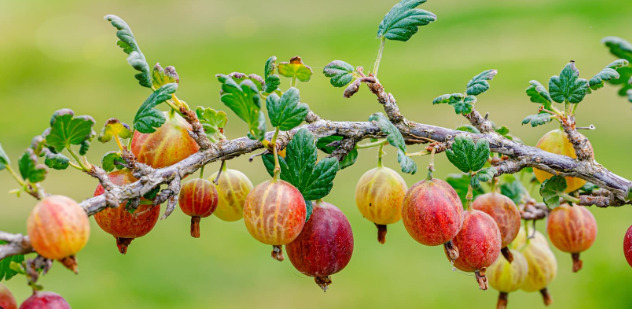The Ultimate Guide to Pruning and Maintaining Your Gooseberry Bush

When it comes to growing delicious and nutritious fruits in your own garden, gooseberries are a quintessential British favorite. These small, tart, and vitamin-packed berries have been gracing our gardens for centuries, offering a versatile ingredient for pies, jams, and desserts. However, to enjoy a bountiful harvest of gooseberries, it’s essential to understand the art of pruning and maintaining your gooseberry bush. In this comprehensive guide, we’ll walk you through the process step by step, ensuring you can cultivate healthy and fruitful gooseberry bushes in your very own garden.
Contents
- 1 The Best Gooseberry Varieties for Your Garden: Insights from Experts
- 2 Chapter 1: Choosing the Right Location
- 3 Chapter 2: Planting Your Gooseberry Bush
- 4 Chapter 3: Pruning Basics
- 5 Winter Pruning (December to February):
- 6 Chapter 4: Fertilizing and Mulching
- 7 Chapter 5: Pest and Disease Management
- 8 Chapter 6: Harvesting and Enjoying Your Gooseberries
- 9 Chapter 7: Long-Term Maintenance
- 10 Conclusion: Enjoy the Fruits of Your Labor
The Best Gooseberry Varieties for Your Garden: Insights from Experts
Before diving into the nitty-gritty of gooseberry bush maintenance, let’s take a moment to explore the best gooseberry bush recommended by experts from ChrisBowers, a renowned authority in fruit tree cultivation. One of their experts said: “One of our top picks is the Invicta Gooseberry. Known for its vigorous growth and excellent disease resistance, this variety produces large, greenish-yellow berries that are perfect for eating fresh or making preserves. It’s an ideal choice for those new to gooseberry cultivation due to its low-maintenance nature”. Then added: “Another fantastic option is the Hinnomaki Red Gooseberry. This variety offers a burst of vibrant red berries that are not only visually appealing but also bursting with flavor. Hinnomaki Red is relatively thorn-free, making it easier to harvest, and it’s disease-resistant, ensuring a healthy crop.”
Now that we’ve highlighted a couple of outstanding gooseberry varieties, let’s delve into the essential practices for pruning and maintaining your gooseberry bush.
Chapter 1: Choosing the Right Location
Before planting your gooseberry bush, selecting the right location is paramount. Gooseberries thrive in well-drained soil and prefer a sunny spot with partial shade, especially in areas with scorching summer sun. Ensure that the soil is rich in organic matter and slightly acidic to create the perfect growing environment for your gooseberry bush.
Chapter 2: Planting Your Gooseberry Bush
Once you’ve chosen the ideal location, it’s time to plant your gooseberry bush. Here’s a step-by-step guide:
Prepare the Soil: Dig a hole that’s slightly larger than the root ball of your gooseberry bush. To enrich the soil, incorporate some compost that has decomposed thoroughly or other organic matter.
Plant the Bush: Place the gooseberry bush in the hole, ensuring that the top of the root ball is level with the surrounding soil. Backfill with soil and water thoroughly.
Spacing: Space multiple gooseberry bushes at least 4-5 feet apart to allow for adequate airflow and room for growth.
Chapter 3: Pruning Basics
Pruning is essential for shaping your gooseberry bush and ensuring a productive harvest. Here’s a yearly pruning routine to follow:
Winter Pruning (December to February):
Remove any dead or diseased branches.
Cut back one-year-old branches by about a third to encourage new growth.
Reduce the thickness of branches that are too close together to promote better air flow.
Summer Pruning (June to July):
Trim back the current season’s growth to five leaves above the fruit clusters. This encourages larger fruit and better air circulation.
Remove any inward-growing or crossing branches.
Chapter 4: Fertilizing and Mulching
Gooseberry bushes benefit from regular fertilizing. In the early spring, before the appearance of new growth, apply a balanced fertilizer. Additionally, mulching around the base of the bush with organic matter helps retain moisture and suppress weeds.
Chapter 5: Pest and Disease Management
Gooseberries are susceptible to various pests and diseases, including gooseberry sawfly, powdery mildew, and aphids. To keep your bushes healthy:
Regular Inspection: Routinely inspect your gooseberry bushes for signs of pests or disease.
Pruning and Thinning: Keep the bush well-pruned to improve air circulation and reduce the risk of disease.
Natural Predators: Encourage natural predators like ladybugs and birds to help control pests.
Organic Treatments: Use organic treatments when necessary to combat pests and diseases.
Chapter 6: Harvesting and Enjoying Your Gooseberries
After all your hard work, it’s time to enjoy the fruits of your labor. Gooseberries are typically ready to harvest from late spring to early summer. Here’s how to do it:
Pick Ripe Berries: Harvest ripe berries by gently plucking them from the bush. They should be slightly soft to the touch and easy to remove from the stem.
Use or Store: Use your gooseberries fresh in pies, jams, or desserts. Alternatively, you can freeze them for later use.
Chapter 7: Long-Term Maintenance
To keep your gooseberry bush healthy and productive year after year, remember these long-term maintenance tips:
Renewal Pruning: Every few years, remove one or two of the oldest branches to encourage new growth.
Weeding and Mulching: Continuously keep the area around the bush free from weeds and refresh the mulch as needed.
Winter Protection: In severe winter climates, consider covering your gooseberry bush with a layer of straw to protect it from frost.
Conclusion: Enjoy the Fruits of Your Labor
In conclusion, growing and maintaining a gooseberry bush can be a rewarding experience for any gardener. With the right care and attention, you can enjoy a bountiful harvest of these delicious and nutritious berries year after year. From choosing the best varieties to mastering the art of pruning and pest control, you now have the ultimate guide to cultivating healthy and productive gooseberry bushes in your very own garden. So, roll up your sleeves, put on your gardening gloves, and start growing your own little piece of British berry heaven. Happy gardening!
Remember that gooseberry cultivation can vary depending on your specific location and climate, so it’s always a good idea to consult with local gardening experts or extension services for region-specific advice. With dedication and a bit of know-how, your gooseberry bush will flourish, providing you with a taste of quintessential British goodness right from your own backyard.






